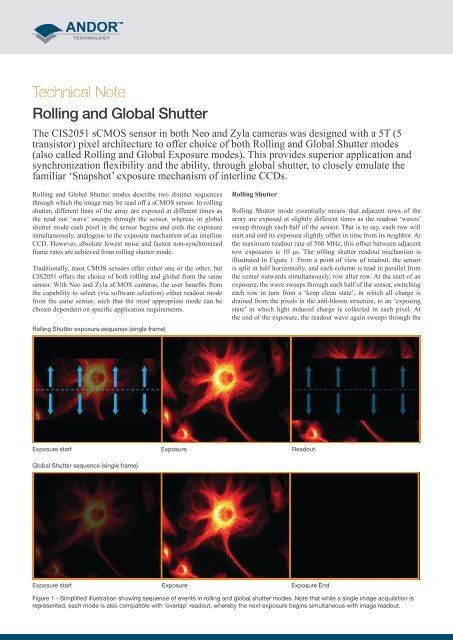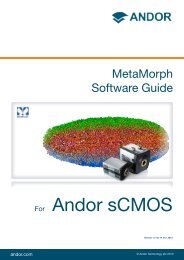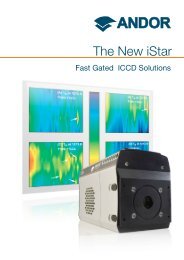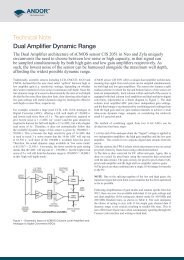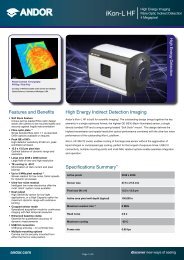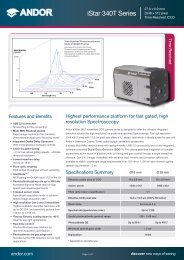Technical Note Rolling and Global Shutter
Technical Note Rolling and Global Shutter
Technical Note Rolling and Global Shutter
You also want an ePaper? Increase the reach of your titles
YUMPU automatically turns print PDFs into web optimized ePapers that Google loves.
<strong>Technical</strong> <strong>Note</strong><strong>Rolling</strong> <strong>and</strong> <strong>Global</strong> <strong>Shutter</strong>The CIS2051 sCMOS sensor in both Neo <strong>and</strong> Zyla cameras was designed with a 5T (5transistor) pixel architecture to offer choice of both <strong>Rolling</strong> <strong>and</strong> <strong>Global</strong> <strong>Shutter</strong> modes(also called <strong>Rolling</strong> <strong>and</strong> <strong>Global</strong> Exposure modes). This provides superior application <strong>and</strong>synchronization flexibility <strong>and</strong> the ability, through global shutter, to closely emulate thefamiliar ‘Snapshot’ exposure mechanism of interline CCDs.<strong>Rolling</strong> <strong>and</strong> <strong>Global</strong> <strong>Shutter</strong> modes describe two distinct sequencesthrough which the image may be read off a sCMOS sensor. In rollingshutter, different lines of the array are exposed at different times asthe read out ‘wave’ sweeps through the sensor, whereas in globalshutter mode each pixel in the sensor begins <strong>and</strong> ends the exposuresimultaneously, analogous to the exposure mechanism of an interlineCCD. However, absolute lowest noise <strong>and</strong> fastest non-synchronizedframe rates are achieved from rolling shutter mode.Traditionally, most CMOS sensors offer either one or the other, butCIS2051 offers the choice of both rolling <strong>and</strong> global from the samesensor. With Neo <strong>and</strong> Zyla sCMOS cameras, the user benefits fromthe capability to select (via software selection) either readout modefrom the same sensor, such that the most appropriate mode can bechosen dependent on specific application requirements.<strong>Rolling</strong> <strong>Shutter</strong><strong>Rolling</strong> <strong>Shutter</strong> mode essentially means that adjacent rows of thearray are exposed at slightly different times as the readout ‘waves’sweep through each half of the sensor. That is to say, each row willstart <strong>and</strong> end its exposure slightly offset in time from its neighbor. Atthe maximum readout rate of 560 MHz, this offset between adjacentrow exposures is 10 μs. The rolling shutter readout mechanism isillustrated in Figure 1. From a point of view of readout, the sensoris split in half horizontally, <strong>and</strong> each column is read in parallel fromthe center outwards simultaneously, row after row. At the start of anexposure, the wave sweeps through each half of the sensor, switchingeach row in turn from a ‘keep clean state’, in which all charge isdrained from the pixels in the anti-bloom structure, to an ‘exposingstate’ in which light induced charge is collected in each pixel. Atthe end of the exposure, the readout wave again sweeps through the<strong>Rolling</strong> <strong>Shutter</strong> exposure sequence (single frame)Exposure startExposureReadout<strong>Global</strong> <strong>Shutter</strong> sequence (single frame)Exposure startExposureExposure EndFigure 1 - Simplified illustration showing sequence of events in rolling <strong>and</strong> global shutter modes. <strong>Note</strong> that while a single image acquisition isrepresented, each mode is also compatible with ‘overlap’ readout, whereby the next exposure begins simultaneous with image readout.
sensor, transferring the charge from each row into the readout nodeof each pixel. The important point is that each row will have beensubject to exactly the same exposure time, but the row at the top orbottom of each sensor half would have started <strong>and</strong> ended its exposure10 ms (1000 rows x 10 μs/row) after the rows at the center of thesensor.<strong>Rolling</strong> <strong>Shutter</strong> can be operated in a continuous ‘overlap’ mode whencapturing a kinetic series of images, whereby after each row has beenread out, it immediately enters its next exposure. This ensures a 100%duty cycle, meaning that no time is wasted between exposures <strong>and</strong>,perhaps more importantly, no photons are wasted. At the maximumframe rate for a given readout speed (e.g. 100 fps at 560 MHz) thesensor is continuously reading out in overlap mode, i.e. as soonas the readout fronts reach the top <strong>and</strong> bottom of the sensor, theyimmediately return to the center to readout the next exposure.A potential downside of rolling shutter is spatial distortion, resultingfrom the above described exposure mechanism. Distortion wouldbe more apparent in cases where larger objects are moving at a ratethat the image readout could not match. However, distortion is lesslikely when relatively small objects are moving at a rate that is beingtemporally oversampled by the frame rate.A further downside is that different regions of the exposed imagewill not be precisely correlated in time to other regions, which canbe essential for some usages. A final, <strong>and</strong> very important, factor isthat synchronizing (e.g. light source activation or peripheral devicemovement) to rolling shutter readouts can be complex <strong>and</strong> alsocan result in slower cycle times <strong>and</strong> frame rates, relative to thoseachievable in global shutter.<strong>Global</strong> <strong>Shutter</strong> – ‘interline CCD mode’<strong>Global</strong> <strong>Shutter</strong> mode, which can also be thought of as a ‘Snapshot’exposure mode, means that all pixels of the array are exposedsimultaneously, thus enabling ‘freeze frame’ capture of fast movingor fast changing events <strong>and</strong> in this respect, global shutter can bethought of as behaving like an interline CCD sensor. Before theexposure begins, all pixels in the array will be held in a ‘keep cleanstate’, during which charge is drained into the anti-bloom structureof each pixel. At the start of the exposure, each pixel simultaneouslybegins to collect charge <strong>and</strong> is allowed to do so for the duration ofthe exposure time. At the end of exposure, each pixel transfers chargesimultaneously to its readout node.<strong>Global</strong> shutter can be configured to operate in a continuous ‘overlap’mode (analogous to interline CCD), whereby an exposure canproceed while the previous exposure is being readout out from thereadout nodes of each pixel. In this mode, the sensor has a 100%duty cycle, again resulting in optimal time resolution <strong>and</strong> photoncollection efficiency. During this entire cycle, there is no period of‘transient’ readout as found in rolling shutter.Importantly, <strong>Global</strong> <strong>Shutter</strong> mode is very simple to synchronize to<strong>and</strong> often yields faster frame rates than efforts to synchronize with<strong>Rolling</strong> <strong>Shutter</strong> with the same exposure time. <strong>Global</strong> shutter canalso be regarded as essential when exact time correlation is requiredbetween different regions of the sensor area.However, the mechanism of global shutter mode dem<strong>and</strong>s that areference readout is performed ‘behind the scenes’, in addition to theactual readout of charge from each pixel. This additional digitizedreadout is required to eliminate reset noise from the global shutterimage. Due to this additional reference readout, global shutter modecarries the trade-off of halving the maximum unsynchronized framerate that would otherwise have been achieved in rolling shutter mode.<strong>Rolling</strong><strong>Global</strong>Snapshot exposure No YesInterline CCD similarityTemporal correlation between differentregions of image areaSynchronizationcapabilityNo - very different ‘transient’ exposuresequenceNo - up to 10 ms (@ 560 MHz) differencebetween centre <strong>and</strong> top or bottom of imageComplex to synchronizeRequires strobe light sourceLonger cycle times.Yes – extremely similar exposure sequenceYes - all pixels represent exact same time ofexposureSimple to synchronizeAny light sourceShorter cycle timesFast double exposure capability No YesMaximum FrameRateMaximum available (non- synchronized)Maximum framerates are halvedRead Noise Lowest possible (1 e - to 1.3 e - ) Slightly higher (2.3 e - to 2.6 e - )Spatial DistortionDuty Cycle EfficiencyPossible if not temporallyoversampling object dynamics or shutteringlight sourceReduced, e.g. if require to shutterillumination off during ‘transient’ readoutphasesNoneTypically much larger since no ‘transient’readout phase to avoidTable 1 - Comparing the pros <strong>and</strong> cons of <strong>Rolling</strong> vs <strong>Global</strong> <strong>Shutter</strong>
Figure 2 – Images of a moving fan, acquired with Neo sCMOS camera with rolling <strong>and</strong> global shutter exposure modes, same exposure time.The spatial distortion associated with the ‘rolling shutter effect’ is apparent in the left image. <strong>Global</strong> shutter is a ‘snapshot’ acquisition mode<strong>and</strong> avoids spatial distortion.<strong>Rolling</strong> or <strong>Global</strong>?Whether rolling shutter or global shutter is right for you will dependvery much on the experiment. <strong>Global</strong> <strong>Shutter</strong> has a ‘non-transient’exposure mechanism that is entirely analogous to that of interlineCCDs, <strong>and</strong> for many will provide the reassurance of ‘freeze frame’capturing of moving objects or transient events during a kineticacquisition series with zero spatial distortion, as well as offeringsimpler <strong>and</strong> faster synchronization performance. For particularapplications, for example where it is required that different regionsof the image maintain temporal correlation or where it is required toaccurately synchronize to relatively short lived events, global shutterwill be viewed as a necessity.Figure 2 shows images of a moving fan, imaged with both rolling <strong>and</strong>global shutter exposure modes of the Neo sCMOS camera, identicalexposure time. Significant spatial distortion (beyond motion blur) ofthe fan blades is apparent in the image captured with rolling shutter,indicative that the blades are moving fast relative to the time taken forthe ‘transient’ exposure.activation /readout sweeps of rolling shutteras they ‘move’ across the blade width. This spatial distortion is oftenreferred to as the ‘rolling shutter effect’.However, <strong>Rolling</strong> <strong>Shutter</strong> mode, with the enhanced non-synchronizedmaximum frame rate possibility <strong>and</strong> lower read noise, is still likelyto suit many scientific applications, e.g. where one simply needs totrack relatively small objects in 2D as a function of time. As long asthe frame rate is such that the camera is temporally oversamplingobject dynamics within the image area, negligible spatial distortionwill be observed in rolling shutter mode. Such oversampling is goodimaging practice, since it is generally undesirable to have an objecttravel a significant distance during a single exposure. However, itmust always be born in mind that, even if distortion is not manifest,an object at the top of bottom of the image will be captured up to 10ms apart from an object at the center of the image: if this is a factor foryour experiment, then rolling shutter should not be used.Short charge transfer time between 2 consecutive exposures with<strong>Global</strong> <strong>Shutter</strong>The global shutter mode of Neo can be used to effect electronicgating, similar to that possible with interline CCDs. Before theexposure, all pixels in the array will be held in a ‘keep clean state’,during which charge is drained into the anti-bloom structure of eachpixel, thus acting as an ‘electronic shutter’. The exposure ‘switchon’ is electronic <strong>and</strong> extremely fast (sub-μs). At the end of exposure,each pixel transfers charge simultaneously to its readout node, againacting as an electronic shutter close mechanism. The transfer timespecification for this step is only 2 μs <strong>and</strong> has been optical measuredto be less than 1 µs.The short transfer time between 2 consecutive images in globalshutter mode lends the Neo to fast ‘double exposure’ applications,such as Particle Imaging Velocimetry (PIV).Synchronizing to <strong>Rolling</strong> <strong>and</strong> <strong>Global</strong> shutterFlexibility to offer both rolling shutter <strong>and</strong> true global shutter canbe considered highly advantageous. <strong>Rolling</strong> shutter delivers absolutelowest read noise <strong>and</strong> is best used for very fast streaming of data (> 50fps full frame) without synchronization to light source or peripheraldevice. However, it carries risk of spatial distortion, especially whenimaging relatively large, fast moving objects. There is no risk of spatialdistortion when using true global shutter. To avoid spatial distortionin rolling shutter a simulated global exposure synchronizationapproach must be used, which requires a pulsed light source <strong>and</strong> alsosignificantly reduces the duty cycle of photon collection (i.e. reducesphotons collected per cycle). By contrast, a 100% duty cycle can bemaintained in global shutter.When synchronizing to fast switching peripheral devices, true <strong>Global</strong><strong>Shutter</strong> mode is relatively simple <strong>and</strong> can result in faster frame rates.While the read noise in global shutter mode (~2.5 e-) is approximatelydouble that of rolling shutter (~ 1.2 e-), this can often be offset against
the higher duty cycles (therefore increased photon collection percycle) <strong>and</strong> higher synchronized frame rates possible in true globalshutter mode.See separate tech note entitled – ‘Synchronizing to sCMOS cameras– Importance of both <strong>Rolling</strong> <strong>and</strong> true <strong>Global</strong> Exposure’‘Gen I’ vs ‘Gen II’ sCMOS?It has been noted with interest that another prominent player inthe sCMOS field has opted to apply the term ‘Gen II’ to a 4T (4transistor) variant of the low noise pixel architecture used in Zyla<strong>and</strong> Neo cameras. While a 4T design can be considered beneficial inaffording a slightly improved Quantum Efficiency response, it doesso at the expense of global shutter capability, thus limiting applicationflexibility <strong>and</strong> synchronization performance.In the author’s opinion, it is a considerable stretch to apply anaggressive ‘Gen II’ marketing label to such a sensor variant, whenboth 4T (rolling shutter) <strong>and</strong> 5T (global shutter) CMOS conceptshave been around for some time <strong>and</strong> are extremely well documented.In fact, it is the architecture of the CIS2051 sCMOS sensor that,if anything, can be considered more innovative, in that it has beenuniquely designed to offer global shutter whilst maintaining rollingshutter capability. When at the design stages, Andor <strong>and</strong> partners hada choice of 4T rolling shutter or the design we opted for – the decisionwas taken based on solid application reasoning.


